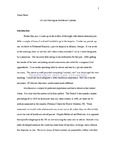US and Norwegian Healthcare Systems

View/
Author
Hurst, Stuart D.
Subject
Washington and Lee University, Shepherd Poverty Program
Medical care
Health insurance
National health services
Norway
Primary health care -- Evaluation
Metadata
Show full item recordDescription
Stuart D. Hurst is a member of the Class of 2007 of Washington and Lee University. Capstone; [FULL-TEXT FREELY AVAILABLE ONLINE] Healthcare is a subject of profound importance and fierce debate in the United States. It is clear that the system is far from perfect. The United States spends a higher percentage of its GDP on healthcare than any other country at 16%, yet there are 45 million uninsured in the country (National Center for Health Statistics, 30). These uninsured are treated with substandard care, or no care at all, unless they are able to fully cover the cost of healthcare out-of-pocket. Despite Medicaid and Medicare, it is apparent that specific subgroups in the US are not receiving the same care as others. Almost every other developed nation in the world has some form of universal coverage which reduces this disparity in care. However, many of these systems are purportedly ridden with their own issues such as high cost and long waiting times. By comparing the US system with a universal system, I can investigate the effectiveness of each in terms of the quality of care provided and the equality of distribution of that care.
Norway is a particularly interesting choice for several reasons. Norway has total coverage of its citizens, but at 10.3% of its GDP, it spends proportionately less money on healthcare than the US. The Norwegian system is also a significantly more regulated form of healthcare, yet it is more decentralized than many of the universal systems, like Canada and the UK. After an overview of both US and Norwegian policy, I will evaluate the statistics and compare the quality and the equality of healthcare in each system. [From Introduction] Stuart Hurst